Puccinia graminis (Stem wheat rust): Difference between revisions
| (9 intermediate revisions by the same user not shown) | |||
| Line 56: | Line 56: | ||
Some of these genes have already been successful in the past, like the <i>Sr26</i> gene which has already been used in the 1970s, 1980s, and it is even being used up to this day (Singh et al., 2011). One of the most important facts about this certain gene strain is that it has remained effective even after it has been used in such large scales. Resistant gene strains tend to lose their potency once they are widely used in a large scale, so <i>Sr26</i>’s continuous effectiveness can give us a cause for hope. The only problem is that this gene has only been used in Australia, so the effect that it would have on other parts of the globe is still unknown. <i>Sr50</i>, which was introduced to wheat from Imperial rye, has also been deployed in Australia, but no varieties have been released (2011). | Some of these genes have already been successful in the past, like the <i>Sr26</i> gene which has already been used in the 1970s, 1980s, and it is even being used up to this day (Singh et al., 2011). One of the most important facts about this certain gene strain is that it has remained effective even after it has been used in such large scales. Resistant gene strains tend to lose their potency once they are widely used in a large scale, so <i>Sr26</i>’s continuous effectiveness can give us a cause for hope. The only problem is that this gene has only been used in Australia, so the effect that it would have on other parts of the globe is still unknown. <i>Sr50</i>, which was introduced to wheat from Imperial rye, has also been deployed in Australia, but no varieties have been released (2011). | ||
[[Image:Wheatresistancevariations.png|thumb|1000px|right|Figure | [[Image:Wheatresistancevariations.png|thumb|1000px|right|Figure 7: Variations of <i>Ug99</i>-resistant wheat that were released in eight countries in 2010. The level of resistance that they had to the fungus was also recorded. http://www.annualreviews.org/doi/pdf/10.1146/annurev-phyto-072910-095423]] | ||
Some of these genes initially seemed highly effective against <i>Ug99</i>, such as gene and <i>Sr35</i>. This gene, after being cultured tested in Australia, was found to be virulent to many of the other races of stem wheat rust throughout the world (Singh et al., 2011). Avirulence to gene <i>Sr28</i> by <i>Ug99</i> was found, but that same gene has also been found to be virulent to many other races of stem rust throughout the world (2011). The virulence and avirulence on these genes suggest that although some genes might be effective against certain races of stem rust, they might be ineffective against others. These findings should remind us that careful planning should be made when deciding which and where different resistant strains should be planted. | Some of these genes initially seemed highly effective against <i>Ug99</i>, such as gene and <i>Sr35</i>. This gene, after being cultured tested in Australia, was found to be virulent to many of the other races of stem wheat rust throughout the world (Singh et al., 2011). Avirulence to gene <i>Sr28</i> by <i>Ug99</i> was found, but that same gene has also been found to be virulent to many other races of stem rust throughout the world (2011). The virulence and avirulence on these genes suggest that although some genes might be effective against certain races of stem rust, they might be ineffective against others. These findings should remind us that careful planning should be made when deciding which and where different resistant strains should be planted. | ||
| Line 68: | Line 68: | ||
The wheat crops that are most widely grown in the countries affected by <i>Ug99</i> are around 10 to 15 years old (Signh et al., 2011). More productive resistant genes have started to be released in different countries (2011). The older strains of wheat should be replaced with resistant strain wheat as soon as possible in order to minimize the area that contains non-resistant wheat strains before and epidemic hits. | The wheat crops that are most widely grown in the countries affected by <i>Ug99</i> are around 10 to 15 years old (Signh et al., 2011). More productive resistant genes have started to be released in different countries (2011). The older strains of wheat should be replaced with resistant strain wheat as soon as possible in order to minimize the area that contains non-resistant wheat strains before and epidemic hits. | ||
===Other Types of Control=== | |||
[[Image:StemRust25.jpg|thumb|400px|left|Figure 8: The "Puccina pathway," which is the movement of urediniospores north by the wind from southern North America and Mexico. http://www.apsnet.org/edcenter/intropp/lessons/fungi/Basidiomycetes/Pages/StemRust.aspx]] | |||
After it was known that the barberry plants were needed for <i>Puccinia graminis</i> to complete its life cycle, North America launched a barberry survey and eradication program in 1918 and still continues of the this day (Schumann and Leonard, 2000). It was believed that by getting rid of the barberry, the stem rust would not have a host to infect once the wheat season was over. Since the stem rust would not have a host, the urediniospores would not be able to survive the winter, ultimately getting rid of stem rust (2000). | |||
Even though North America was not able to get rid of the problem due to the “Puccina pathway, (Figure 8)” which is the movement of urediniospores from southern U.S. and Mexico northward following wind currents, it did have some positive effects on the control of the epidemic (Schumann and Leonard, 2000). One of the positive effects is that it removed a huge source of spore production, since a single plant can produce billions of aeciospores (2000). By getting rid of one of the biggest sources of pollen, the dispersal of stem rust has slowed down dramatically (2000). The program also got rid of the sexual cycle of P. graminis, which dramatically reduced the amount of new strains that the fungi usually produced. This is due to the fact that the fungi can now only mostly reproduce asexually. One of the biggest successes of this program is that it decreased the amount of races of wheat stem rust since now its primary source of genetic variation is the slower process of mutation (2000). | |||
==Conclusion== | ==Conclusion== | ||
< | Overall, stem wheat rust is a really big problem that we must find a solution to before it is too late. If we do not find a solution to stop the expansion of <i>Puccinia graminis</i>, or at least slow down its expansion, one of the largest producers of wheat will be destroyed (Signh et al., 2008). It has been estimated that around 85% of the global population require wheat as one of their only calorie source, it has also been estimated 60% depend on it as their protein source, with that number increasing to 82% if we take into account the countries that use wheat as their secondary or tertiary source of protein (2008). | ||
With such a large number of people depending on the global production of wheat, we cannot allow one of the largest producers of wheat to get hit by the <i>Ug99</i> epidemic without being prepared. There are many different ways to prevent the expansion of stem wheat rust, including the eradication of barberry, the use of fungicides, and the use of genetic manipulation to create wheat stains that are resistant against <i>Ug99</i> as well as other races. The eradication of barberry is not enough as it was proven in North America, and the use of fungicides has proven to be too expensive (Schumann and Leonard, 2000). With most other types of control not being good enough to stop the spread of <i>Ug99</i>, it seems that the only way to combat the spread of stem wheat rust seems to be genetic engineering (Singh et al., 2011). | |||
Studies have been made since 2005, by having gene transfer from species related to wheat into the wheat genome. So far there are promising results that can give us hope to stop the expansion since multiple variations of genes resistant to <i>Ug99</i> and other races have been found (Signh et al., 2011). Not only are the results encouraging, but the fact that different countries, international organizations, private seed companies, and farmers have been cooperating gives hope that with enough work and cooperation, the goal of avoiding a food production catastrophe could be achieved (2011). | |||
==References== | ==References== | ||
[ | [http://www.sciencemag.org/content/297/5581/537.full.pdf Brown, J. K. M., and Hovmller, M. S. (2002). Aerial dispersal of pathogens on the global and continental scales and its impact on plant disease. Science 297, 537–541.] | ||
[http://onlinelibrary.wiley.com/doi/10.1111/j.1439-0523.2005.01136.x/pdf Mishra, A. N., K. Kaushal, S. R. Yadav, G. S. Shirsekar, and H. N. Pandey. "The Linkage between the Stem Rust Resistance Gene Sr2 and Pseudo-black Chaff in Wheat Can Be Broken." Plant Breeding 124.5 (2005): 520-22. Print.] | |||
[http://apsjournals.apsnet.org/doi/abs/10.1094/PDIS.2000.84.2.203B Pretorius, Z. A., R. P. Singh, W. W. Wagoire, and T. S. Payne. "Detection of virulence to wheat stem rust resistance gene Sr31 in Puccinia graminis. f. sp. tritici in Uganda." Plant Disease 84, no. 2 (2000): 203-203.] | |||
[http://www.apsnet.org/edcenter/intropp/lessons/fungi/Basidiomycetes/Pages/StemRust.aspx Schumann, G.L. and K.J. Leonard. 2000. Stem rust of wheat (black rust). The Plant Health Instructor. DOI: 10.1094/PHI-I-2000-0721-01. Updated 2011.] | |||
[http://naldc.nal.usda.gov/download/36520/PDF Singh, Ravi P., David P. Hodson, Julio Huerta-Espino, Yue Jin, Peter Njau, Ruth Wanyera, Sybil A. Herrera-Foessel, and Richard W. Ward. "Will stem rust destroy the world's wheat crop?." Advances in agronomy 98 (2008): 271-309.] | |||
[http://www.cropscience.org.au/icsc2004/symposia/3/7/141_singhrp.htm Singh, R. P., William, H. M., Huerta-Espino, J., and Rosewarne, G. (2004b). Wheat rust in Asia: Meeting the challenges with old and new technologies. In ‘‘New Directions for a Diverse Planet: Proceedings ofthe 4th International Crop Science Congress,’’http://www.cropscience.org.au./icsc2004/symposia/3/7/141_singhrp.htm(accessed on April 18, 2013). September 26–October 1, 2004. Brisbane, Australia.] | |||
[http://www.annualreviews.org/doi/pdf/10.1146/annurev-phyto-072910-095423 Singh, Ravi P., David P. Hodson, Julio Huerta-Espino, Yue Jin, Sridhar Bhavani, Peter Njau, Sybil Herrera-Foessel, Pawan K. Singh, Sukhwinder Singh, and Velu Govindan. "The Emergence of Ug99 Races of the Stem Rust Fungus Is a Threat to World Wheat Production." Annual Review of Phytopathology 49.1 (2011): 465-81. Print.] | |||
Edited by student of [mailto:slonczewski@kenyon.edu Joan Slonczewski] for [http://biology.kenyon.edu/courses/biol238/biol238syl10.html BIOL 238 Microbiology], | Edited by student of [mailto:slonczewski@kenyon.edu Joan Slonczewski] for [http://biology.kenyon.edu/courses/biol238/biol238syl10.html BIOL 238 Microbiology], 2013, [http://www.kenyon.edu/index.xml Kenyon College]. | ||
<!--Do not edit or remove this line-->[[Category:Pages edited by students of Joan Slonczewski at Kenyon College]] | <!--Do not edit or remove this line-->[[Category:Pages edited by students of Joan Slonczewski at Kenyon College]] | ||
Latest revision as of 00:17, 30 April 2013
Introduction

By Rafael Contreras Rangel
Wheat stem rust, also known as black rust, is caused by the fungus Puccinia graminis and it has recently acquired much attention due to the danger it displays to the global wheat productions in the near future. Although wheat stem rust is not the most common rust disease of wheat rust, with wheat leaf rust being the most common, it certainly currently is the most dangerous (Signh, et al 2008).
Wheat resistance to stem rust was largely believed to be held in the gene Sr31 (Pretorious et al., 2000). But on February 1999, large amounts of stem rust were observed in Uganda’s wheat plantations (2000). After running studies for the resistance in wheat for stem rust, it was found that a new strain of stem rust had mutated, making the resistance to stem rust that was found in Sr31 obsolete. This new strain of stem rust was name Ug99 due to its country of origin and the year it was discovered.
Not only does Ug99 carry virulence to gene Sr31, but overtime it has also mutated to be resistant against most variations of stem wheat rust resistance that originated in wheat itself (Singh et al., 2008). Due to this fact, genetic engineering has started to be employed in order to try and find resistance genes in species closely related to wheat. These genes could then be transferred to wheat and give it resistance against the different variations of Ug99 as well as other different races of wheat rust.
It is extremely important to find a way to stop the expansion of Ug99. Although the exact route of expansion of the Ug99 strain is unknown, models have given it the trajectory to reach India, whose wheat production is one of the highest in the world (Figure 1). It has been estimated that 85% of the global population require wheat as one of their only calorie sources (Singh et al., 2008). If a way to stop the Ug99 strain is not found, one of the world’s largest sources of wheat could be destroyed, and it would bring a major food scarcity problem down with it.
Disease Cycle
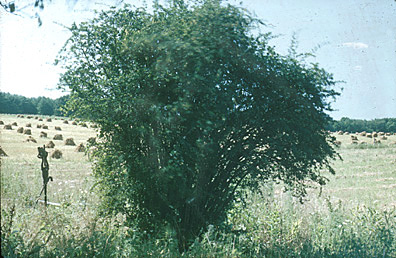
Puccinia graminis is an obligate parasite, meaning that it requires living in another organism, benefiting from it while the host organism is usually being stressed or eventually killed in the process. P. graminis is also heteroecious, which means that the fungus requires living in two distantly related species throughout its life cycle. These two distantly related species that stem wheat rust requires are wheat and barberry plants (Schumman and Leonard, 2000). Barberries are a type of shrub that is either deciduous or evergreen, and it can be found in temperate and subtropical regions (Figure 2). While the best mode of reproduction for P. graminis is by completing its life cycle in both wheat and barberry, it can still grow without having to infect the barberry by acquiring aeciospores from other regions (Schumann and Leonard, 2000).
The life cycle of the stem wheat rust starts by the introduction of either an aceciospore or a urediniospore to a wheat plant. The spores can either come from a distant region carried by the wind, from barberry, the alternate host, or from the wheat plant itself if it is already infected. The pathway cycle that the disease will take depends on the region where the wheat is being grown. Temperate regions mostly only grow wheat during the springs since the winters are too cold for wheat to grow. So the plants in temperate regions may either be exposed to aeciospores from barberry or from uredinospores being carried by the wind from the south, where wheat is grown year-round or just at an earlier time than the wheat in the north (Schumann and Leonard, 2000). The complete life cycle of Puccinia graminis can be seen on the figure below (Figure 3).
Disease Cycle with Barberry
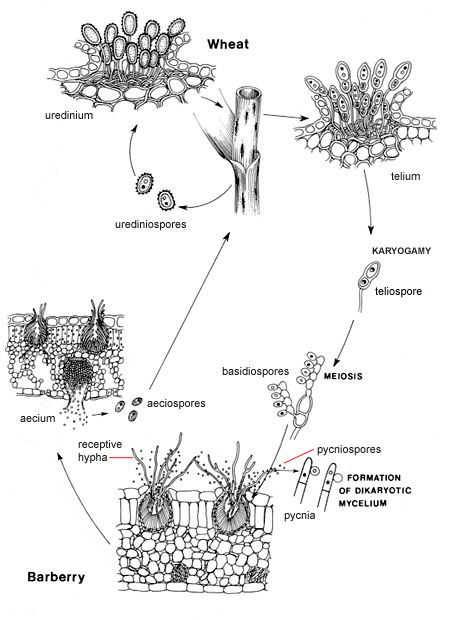
The teliosperes of Puccinia graminis are not able to germinate unless they are exposed to cold temperatures for a substantial amount of time. Due to this fact, the stem wheat disease that includes barberry mostly happens in the temperate regions where the cold temperatures of winter allow the teliospores to germinate (Schumann and Leonard, 2000). Once the growing season is over in the temperate regions, the barberry acts as a host for P. graminis. After the winter is over, the barberry can pass on the disease to wheat.
Towards the end of the growing season, diploid teliospores are produced. Teliospores appear as thick black stripes on the stems of the wheat. Once the winter is over, teliospores then germinate in the spring to haploid basidiospores, which appear to have no color and have really thin walls unlike the teliospores. These haploid basidiospores are the one that infect the barberry (Schumann and Leonard, 2000).
In order to infect the barberry, the basidospores have to germinate and produce haploid mycelium. These haploid myceliums then infect the surface of the leaves of the barberry. Once on the leaves, the haploid mycellims are able to produce Pycnia. Once on this form, the fungus is able to infiltrate the leaf. Inside the leaf, the pycnia produces receptive hyphae and pycniospores. The pycniospores of an individual plant can only be fertilized by the pycniospores of a different host plant (Schumann and Leonard, 2000)
The production of pycniospores is important since it allows cross-fertilization to happen. The pycniospores are spread thanks to the insects that are attracted to the honeydew that is produced alongside the pycniospores. Cross-fertilization between plants produces dykaryotic mycelium. This is one of the most important steps in the life cycle of P. graminis since it allows its transfer from one of its host, the barberry, to the other, wheat (Schumman and Leonard, 2000).
Once the barberry is infected, only a few days have to pass in order for aecium to grow from the dikaryotic mycelium through its leaves. The dikaryotic myselium is able to produce aeciospores, which can infect wheat or other grass hosts. Once the wheat is infected, P. graminis is able to produce another set of dycariotic mycelium, which ultimately is able to produce its own dikaryotic urediniospores (Schumman and Leonard, 2000). The production of these spores can start the “repeating cycle” in crops with favorable conditions since urediniospores can only infect the host plant that produced them (2000). Once the growing season ends, teliospores are formed again on the stem of the wheat in order to start the cycle all over again.
Disease Cycle without Barberry
In North America, the Great Plains are a great example to show how Puccinia graminis spreads without barberry. Since the winter is too cold for the spores to survive, uredinospores from other regions need to be donated. The uredinospores from the warmer Great Plains of the south can then be introduced to the northern Great Plains by northward blowing wind. Since wheat is usually planted on the south earlier than on the north, there always seems to be a fresh batch of spores just waiting to be picked up by the wind. The disease ends once the wheat season of the north is over (Schumman and Leonard, 2000).
It is worth noting that the cycle starts again on the south by having uredinospores that were produced by the wheat planted for the fall infect the wheat seedlings planted for the winter. In the south, P. graminis is able to survive the winter since the temperature is not as cold. The infected winter wheat then infects the summer wheat crops and the spores from those crops eventually find their way north again (Schumman and Leonard, 2000).
Symptoms, Dispersal, and Environmental conditions
Symptoms
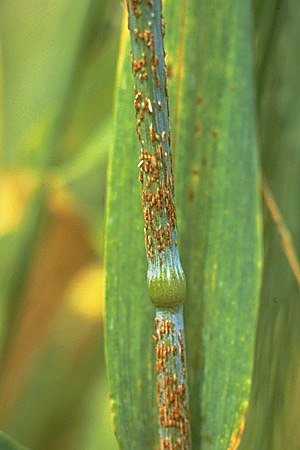
The symtoms of stem wheat rust are not apparent until a few days have passed from the day of infection. Most of the time the symtoms start to be noticeable after 7 to 15 days have passed (Schumann and Leonard, 2000). After those few days, uredinia start to appear. Uredinia appear as little red dots on the stem or leaves of the wheat (2000). They sometimes appear to be slightly crystallized (Figure 4). Once the end of the season is nearing, the uredinia start to decrease and the teliospores start to form (Figure 5).
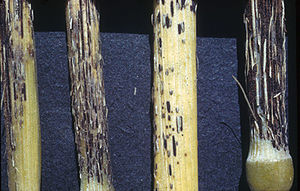
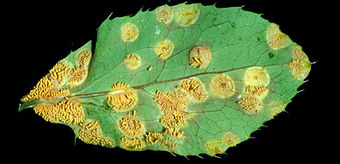
The symptoms of the infected barbery are similar to those of wheat. In the spring, before the wheat is present, pycnia starts to form on the surface of the leaves (Schumman and Leonard, 2000). The infection starts to be noticeable a little earlier than on wheat, since the infection starts to be noticeable after 5 to 10 days. After that time, the aeciospores break open through the bottom of the leaves (Figure 6)
Dispersal and Environmental Conditions
There are three modes of transportation that the uredinospores can take. One of them is long distance dispersal by a single event as well as assisted dispersal, the second one being stepwise range expansion, and the third being extinction and recolonization (Singh et al., 2008). All of these modes of transportations have been observed before, although some of them are more common than others.
Dispersal by a single even is the most rare of all the modes. This type of mode includes the movement of the uredinospores across whole continents. Although it has been noted that this type of transportation is extremely rare, it has been recorded before. Brown and Hovmoller report that stem rust spores have moved up to 8000 km from the south of Africa all the way to Australia (2002). Although these events are rare, the ability for spores the withstand a high range of environmental pressures make these large distance travels completely possible (Singh et al., 2008) Another type of dispersal by a single even is assisted dispersal. Unlike the previous example, humans mostly cause assisted dispersal. In assisted dispersal, the spores mostly travel on clothing as well as through the trade of infected wheat (2008)
Unlike dispersal by a single event, the second mode of even travels in smaller distance as well as it takes more time for the spores to travel. Stepwise range expansion does not expand across continents like single event dispersal. This type of transportation mostly spreads at the slightly smaller scale of countries and regions. Out of all the transportation modes, this is the most common one. The current expansion of the stem rust strain Ug99 is an example of stepwise range expansion. The strain first originated in Uganda in 1999, hence getting its name, then migrated into the Middle East, and now has made its way into Asia (Singh et al., 2004). Although the effects that Ug99 has left in its path are devastating, its slow expansion, taking it 10 years to spread to Asia, are giving scientists time to try and come up with a wheat resistant strain against Ug99 before it reaches India.
The third and last mode of dispersal is extinction and recolonization. Although it is generally believed to be a different mode of dispersal, it is much similar to the stepwise range mode of expansion. Both of these modes expand through smaller distances, as well as move much slower than the single event mode. The only difference is that this type of dispersal happens on land that is too stressful for the spores to survive (Singh et al., 2008). The “Puccina pathway” of North America, where spores are transferred by wind from south to north, exemplifies the extinction and recolonization mode, since the disease eventually ends once the wheat season is over (Schumann and Leonard, 2000).
Expansion Control by Genetic Engineering
Even though there are many different types of control out there, it is evident that by far, gene manipulation is the most effective way to combat the stem wheat rust gene strain Ug99 (Schumann and Leonard., 2000). Recently, 50 strains of resistant genes have already been cataloged, although not all of them work with all the different strains that Ug99 displays (Singh et al., 2011). Only a few genes have been found effective against most of Ug99 variations, including Sr22, Sr26, Sr35, and Sr50 (2011).
Some of these genes have already been successful in the past, like the Sr26 gene which has already been used in the 1970s, 1980s, and it is even being used up to this day (Singh et al., 2011). One of the most important facts about this certain gene strain is that it has remained effective even after it has been used in such large scales. Resistant gene strains tend to lose their potency once they are widely used in a large scale, so Sr26’s continuous effectiveness can give us a cause for hope. The only problem is that this gene has only been used in Australia, so the effect that it would have on other parts of the globe is still unknown. Sr50, which was introduced to wheat from Imperial rye, has also been deployed in Australia, but no varieties have been released (2011).
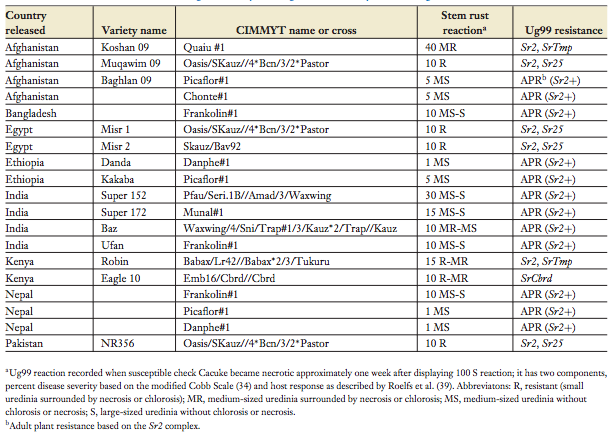
Some of these genes initially seemed highly effective against Ug99, such as gene and Sr35. This gene, after being cultured tested in Australia, was found to be virulent to many of the other races of stem wheat rust throughout the world (Singh et al., 2011). Avirulence to gene Sr28 by Ug99 was found, but that same gene has also been found to be virulent to many other races of stem rust throughout the world (2011). The virulence and avirulence on these genes suggest that although some genes might be effective against certain races of stem rust, they might be ineffective against others. These findings should remind us that careful planning should be made when deciding which and where different resistant strains should be planted.
The combination of different resistance genes in a wheat plant can also give synergistic effects. There is evidence that genes that on their own only have moderate resistance to Ug99 actually have high levels of resistance when paired with another one. This is certainly the case with gene SrCad and Lr34. SrCad gives moderate resistance to Ug99 while Lr34, a leaf wheat rust resistance gene, slows the rusting of the leaves (Singh et al., 2011).
There are also genes that display resistance to the Ug99 strain but are linked to undesirable traits in the wheat plant (Signh et al., 2011). This could to be true for gene Sr2, which has been known to display slow rusting resistance. The problem with this gene is that it has been the general belief that this certain gene is linked to pseudo black chaff expression. Pseudo black chaff expression is often seen as a marker for disease and physiological disorders. But studies have shown that this detrimental linkage can be broken (Mishra et al., 2005), as well as this gene is starting to be used to create Ug99 resistant wheat crops (Signh et al., 2011).
There are many different things that have been done in order to reduce the Ug99 risk. One of them is the promotion of Ug99 resistant varieties in the farmer’s wheat fields since they are not able to afford chemicals to apply to their crops if an epidemic hits (Singh et al., 2011). There has also been continuous testing of high-yielding resistant wheat from international centers in order to try and increase the resistance variety of already existing high yielding wheat (2011).
In order to increase the Ug99 resistant varieties in the farmer’s wheat fields, there have been screenings of wheat from countries that have already been affected by the Ug99 strain. The screenings of plants materials from up to 22 countries have been taking place in Kenya and Ethiopia since 2005 (Signh et al., 2011). This program has been successful since a variety of gene resistant crops have been deployed in eight different countries including Egypt, Afghanistan, and India to name a few (Figure 7). These efforts have been done through the collaboration of many different programs, farmers, and private organizations.
The wheat crops that are most widely grown in the countries affected by Ug99 are around 10 to 15 years old (Signh et al., 2011). More productive resistant genes have started to be released in different countries (2011). The older strains of wheat should be replaced with resistant strain wheat as soon as possible in order to minimize the area that contains non-resistant wheat strains before and epidemic hits.
Other Types of Control

After it was known that the barberry plants were needed for Puccinia graminis to complete its life cycle, North America launched a barberry survey and eradication program in 1918 and still continues of the this day (Schumann and Leonard, 2000). It was believed that by getting rid of the barberry, the stem rust would not have a host to infect once the wheat season was over. Since the stem rust would not have a host, the urediniospores would not be able to survive the winter, ultimately getting rid of stem rust (2000).
Even though North America was not able to get rid of the problem due to the “Puccina pathway, (Figure 8)” which is the movement of urediniospores from southern U.S. and Mexico northward following wind currents, it did have some positive effects on the control of the epidemic (Schumann and Leonard, 2000). One of the positive effects is that it removed a huge source of spore production, since a single plant can produce billions of aeciospores (2000). By getting rid of one of the biggest sources of pollen, the dispersal of stem rust has slowed down dramatically (2000). The program also got rid of the sexual cycle of P. graminis, which dramatically reduced the amount of new strains that the fungi usually produced. This is due to the fact that the fungi can now only mostly reproduce asexually. One of the biggest successes of this program is that it decreased the amount of races of wheat stem rust since now its primary source of genetic variation is the slower process of mutation (2000).
Conclusion
Overall, stem wheat rust is a really big problem that we must find a solution to before it is too late. If we do not find a solution to stop the expansion of Puccinia graminis, or at least slow down its expansion, one of the largest producers of wheat will be destroyed (Signh et al., 2008). It has been estimated that around 85% of the global population require wheat as one of their only calorie source, it has also been estimated 60% depend on it as their protein source, with that number increasing to 82% if we take into account the countries that use wheat as their secondary or tertiary source of protein (2008).
With such a large number of people depending on the global production of wheat, we cannot allow one of the largest producers of wheat to get hit by the Ug99 epidemic without being prepared. There are many different ways to prevent the expansion of stem wheat rust, including the eradication of barberry, the use of fungicides, and the use of genetic manipulation to create wheat stains that are resistant against Ug99 as well as other races. The eradication of barberry is not enough as it was proven in North America, and the use of fungicides has proven to be too expensive (Schumann and Leonard, 2000). With most other types of control not being good enough to stop the spread of Ug99, it seems that the only way to combat the spread of stem wheat rust seems to be genetic engineering (Singh et al., 2011).
Studies have been made since 2005, by having gene transfer from species related to wheat into the wheat genome. So far there are promising results that can give us hope to stop the expansion since multiple variations of genes resistant to Ug99 and other races have been found (Signh et al., 2011). Not only are the results encouraging, but the fact that different countries, international organizations, private seed companies, and farmers have been cooperating gives hope that with enough work and cooperation, the goal of avoiding a food production catastrophe could be achieved (2011).
References
Edited by student of Joan Slonczewski for BIOL 238 Microbiology, 2013, Kenyon College.
